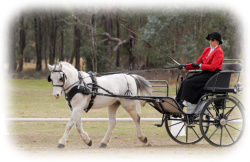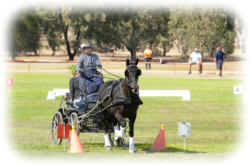Combined Driving Events



CDE Convenor: Form E - Non ACDS Groom Participation Form
Lorraine Cairns lorrainecairns27@gmail.com
CDE Panel:
Belinda Drury 1965bdrury@gmail.com
Rachel Haslau rachelhaslau@yahoo.com.au
Peter Lee teampeterlee@gmail.com
Bernadette Lewis bernadette.lewis38@gmail.com
Nicole Linic nicole.linic@gmail.com
The Combined Driving Event (CDE) is modelled along the lines of a ridden Three Day Event. It was devised by Prince Philip along with other driving enthusiasts some forty years ago.
The competition is divided into three major Competitions - Dressage, Marathon or Cross Country and Cone Driving.
Competition A - Dressage
Dressage is similar to ridden dressage - specific movements are required to be performed in a defined arena. Tests require the driver to display control through voice, whip and reins, and the horses must display obedience, impulsion and correct paces. Movements and paces may include a walk , working, collected and extended trot or canter, serpentines, loops, circles a halt and reinback. One of the more difficult elements requires the driver to execute a one handed circle, this is to demonstrate the driver has control should the whip need to be used. Driven dressage arenas are 40m x 100m or 40m x 80m.
Competition B - The Marathon or Cross Country
This is the most exciting phase of the overall competition. Horses need to be fit to cover the distance in the required time. The course is divided into three timed sections A, D & E and includes a Compulsory Walk in Section D.
Each height class has different times for each section and time penalties may be incurred. Drivers carry spares with them in case of gear or vehicle breakage. Spares may include extra traces, stainless steel clips, a knife, adhesive tape etc. Each competitor also carries maps of the course and stopwatches. A vet check takes place at the end of Section D to ensure horses are fit enough to continue. Section E is the most thrilling part of competition and it is here that competitions can be won or lost. Each marathon obstacle is a series of lettered "gates" which must be negotiated in correct sequence. Every competitor is timed and the faster the time the fewer the penalties. Drivers, when walking the course, take note of where shortcuts can be taken to reduce their time. Another vet check ½ an hour after the end of the marathon makes sure horses are not distressed or lame.
Competition C - Cone Driving
This phase effectively replaces the showjumping round in a ridden event. The "Cones" are similar to traffic cones and each has a ball placed on top. If a ball is dislodged the driver receives 3 penalty points. Drivers have 20-30 cm clearance between their wheel widths and the cone. The course must be driven in correct numerical sequence and again each height class has its own time allowed. The Cone Drive is designed to test the fitness of the horse after the rigours of the Marathon, although in a two day competition the Cones is usually run following the Dressage.
Classes & Combinations
Classes cover experience Novice, Intermediate or Open and are also divided according to the height of the horse or pony.
Combinations used in Carriage Driving Competitions are - Single, Pair, Tandem & Team or Four-In-Hand.
Singles are one horse or pony driven in a two or four wheeled carriage.
Pairs, two driven side by side in a four wheeled vehicle, are most exciting to watch through the marathon obstacles as they make impossibly tight turns and fit through the smallest gaps with the grooms leaning out to give the vehicle correct balance and stability.
Tandems, two driven one behind the other, usually driven in four wheel vehicles these days, in good hands, look elegant and easy to drive though they are a most difficult combination. Tandems are an old tradition by which the family went to the hunt. The old cart horse would be in the wheel (between the shafts) and in draught doing all the work and the flashy, showy hunter would be in the lead, doing no work, thus arriving fresh at the hunt.
Finally, the Teams or Four-in-Hands, one pair in front of another pair, look absolutely spectacular. It is no easy task getting four horses working together in unison either in Dressage or in the marathon obstacles. Driving a team is the ultimate experience and drivers who make it look easy have undoubtedly spent much time perfecting their craft. Always driven in 4 wheeled vehicles there are often new innovations in vehicle design which give increased speed and articulation to the outfit, allowing tighter turns and faster manoeuvres.
Updated July 11th, 2023